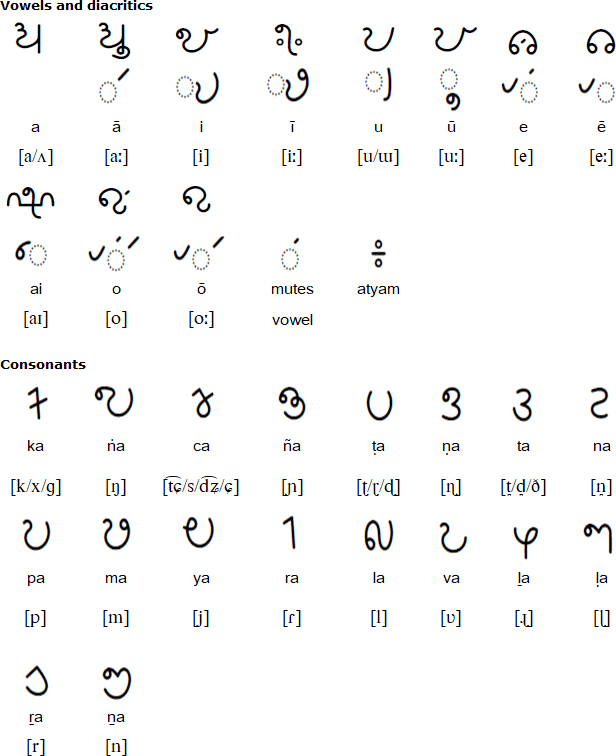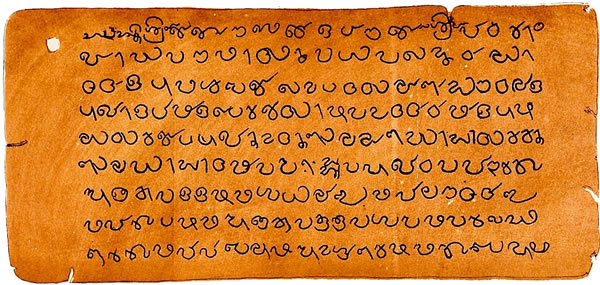The Vatteluttu script first appeared in stone inscriptions in southern India dating from the 4th century AD. It probably developed from the Tamil-Brahmi script, a variant of the Brahmi script used to write Old Tamil between from about the 3rd century BC until the 1st century AD.
Vatteluttu was used to write Tamil and Malayalam in Tamil Nadu until the 9th century. The modern Tamil alphabet developed from the Pallava script, which was created in the 4th century AD, with some letters based on Vatteluttu.
In Kerala, Vatteluttu continued to be used until the 15th century. It changed over time to become the Malayalam script, with some letters borrowed from the Grantha script. Vatteluttu also developed into the Koleluttu script, which was used, especially by Christians and Muslims, in Kerala until the 19th century.
Inscriptions in the Vatteluttu script dating from the 5th-8th century AD have also been found near Trincomalee (திருகோணமலை) in north eastern Sri Lanka
The name Vatteluttu is thought to mean either 'rounded script', 'northern script' or 'chiseled script'.

Download an alphabet chart for Vatteluttu (Excel format)

Royal charter (plate I, side I) issued by the Chera/Perumal king of Kerala, south India to Joseph Rabban, a Jewish merchant magnate of Kodungallur.
Source: https://en.wikipedia.org/wiki/Vatteluttu
Details supplied by Biswajit Mandal (biswajitmandal[dot]bm90[at]gmail[dot]com)
Information about the Vatteluttu script
https://en.wikipedia.org/wiki/Vatteluttu
https://www.unicode.org/L2/L2016/16068-vatteluttu.pdf
Ahom, Aima, Arleng, Badagu, Badlit, Basahan, Balinese, Balti-A, Balti-B, Batak, Baybayin, Bengali, Bhaiksuki, Bhujimol, Bilang-bilang, Bima, Blackfoot, Brahmi, Buhid, Burmese, Carrier, Chakma, Cham, Cree, Dehong Dai, Devanagari, Dham Lipi, Dhankari / Sirmauri, Ditema, Dives Akuru, Dogra, Ethiopic, Evēla Akuru, Fox, Fraser, Gond, Goykanadi, Grantha, Gujarati, Gunjala Gondi, Gupta, Gurmukhi, Halbi Lipi, Hanifi, Hanuno'o, Hočąk, Ibalnan, Incung, Inuktitut, Jaunsari Takri, Javanese, Kaithi, Kadamba, Kamarupi, Kannada, Kawi, Kharosthi, Khema, Khe Prih, Khmer, Khojki, Khudabadi, Kirat Rai, Kōchi, Kodava Lipi, Komering, Kulitan, Kurukh Banna, Lampung, Lanna, Lao, Lepcha, Limbu, Lontara/Makasar, Lota Ende, Magar Akkha, Mahajani, Malayalam, Meitei (Modern), Manpuri (Old), Marchen, Meetei Yelhou Mayek, Meroïtic, Masarm Gondi, Modi, Mon, Mongolian Horizontal Square Script, Multani, Nandinagari, Newa, New Tai Lue, Ojibwe, Odia, Ogan, Pahawh Hmong, Pallava, Phags-pa, Purva Licchavi, Qiang / Rma, Ranjana, Rejang (Kaganga), Sasak, Savara, Satera Jontal, Shan, Sharda, Sheek Bakrii Saphaloo, Siddham, Sinhala, Sorang Sompeng, Sourashtra, Soyombo, Sukhothai, Sundanese, Syloti Nagri, Tagbanwa, Tai Noi, Takri, Tamil, Tanchangya (Ka-Pat), Tani, Thaana, Telugu, Thai, Tibetan, Tigalari, Tikamuli, Tocharian, Tolong Siki, Vatteluttu, Warang Citi
Page last modified: 15.03.23
[top]
You can support this site by Buying Me A Coffee, and if you like what you see on this page, you can use the buttons below to share it with people you know.

If you like this site and find it useful, you can support it by making a donation via PayPal or Patreon, or by contributing in other ways. Omniglot is how I make my living.
Note: all links on this site to Amazon.com, Amazon.co.uk
and Amazon.fr
are affiliate links. This means I earn a commission if you click on any of them and buy something. So by clicking on these links you can help to support this site.
[top]